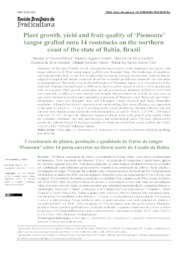Plant growth, yield and fruit quality of 'Piemonte' tangor grafted onto 14 rootstocks on the northern coast of the state of Bahia, Brazil.
Plant growth, yield and fruit quality of 'Piemonte' tangor grafted onto 14 rootstocks on the northern coast of the state of Bahia, Brazil.
Autoria: FRANÇA, N. de O.; GIRARDI, E. A.; AMORIM, M. da S.; GESTEIRA, A. da S.; PASSOS, O. S.; SOARES FILHO, W. dos S.
Resumo: In the state of Bahia, Brazil, citrus production is mainly on the Northern Coast region, with major cultivation of ?Pera? sweet orange grafted onto ?Rangpur? lime. The production of mandarins and mandarin-like fruits is very low in spite of the increasing regional consumption. Varieties that are adapted to tropical sub humid conditions should be evaluated on different rootstocks for cultivation recommendation. This study assessed the performance of ?Piemonte? tangor over 14 rootstocks in Rio Real, BA. Planting was performed in 2006 on a cohesive yellow argisol, at 6.0 m x 4.0 m spacing and with no irrigation. Plant growth, production, and physicochemical attributes of fruits in 2010-2014 were assessed, in addition to tree survival and drought tolerance based on leafroll. At nine years of age, rootstocks that induced greater cumulative production of ?Piemonte? were ?Riverside? and ?Indio? citrandarins, ?Santa Cruz Rangpur? lime, and ?Cleopatra?, ?Sunki Tropical? and ?Sunki Maravilha? mandarins. Although four hybrid rootstocks were semidwarfing, their mean efficiency was equivalent to the other rootstocks (? 5.5 kg m-3), resulting in the lowest production. Drought tolerance and tree survival were similar among rootstocks with minimal loss, except for TSKFL x CTSW - 049 hybrid with only 33.33% of survival. ?Piemonte? tangor produced fruits with general good quality under the evaluated conditions, but only peel thickness and technological index (TI) were influenced by rootstocks, with the lowest TI averages recorded for fruits harvested from scions grafted onto TSKC x (LCR x TR) - 001 and ?Volkamer? lemon.
Ano de publicação: 2018
Tipo de publicação: Artigo de periódico
Unidade: Embrapa Mandioca e Fruticultura
Palavras-chave: Fruta Cítrica, Poncirus Trifoliata
Observações
1 - Por padrão são exibidas publicações dos últimos 20 anos. Para encontrar publicações mais antigas, configure o filtro ano de publicação, colocando o ano a partir do qual você deseja encontrar publicações. O filtro está na coluna da esquerda na busca acima.
2 - Para ler algumas publicações da Embrapa (apenas as que estão em formato ePub), é necessário ter, no celular ou computador, um desses softwares gratuitos. Sistemas Android: Google Play Livros; IOS: iBooks; Windows e Linux: software Calibre.
Acesse outras publicações
Acesse a Base de Dados da Pesquisa Agropecuária (BDPA) para consultar o acervo completo das bibliotecas da Embrapa.

